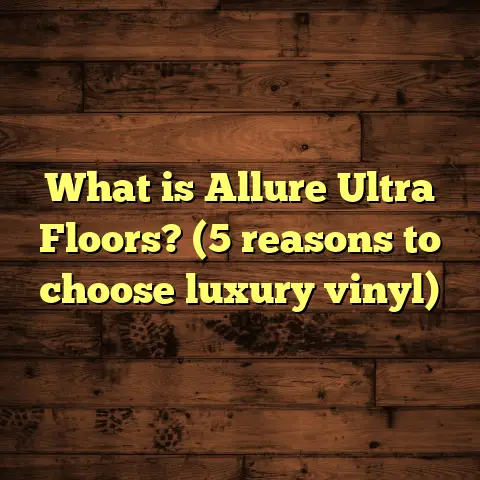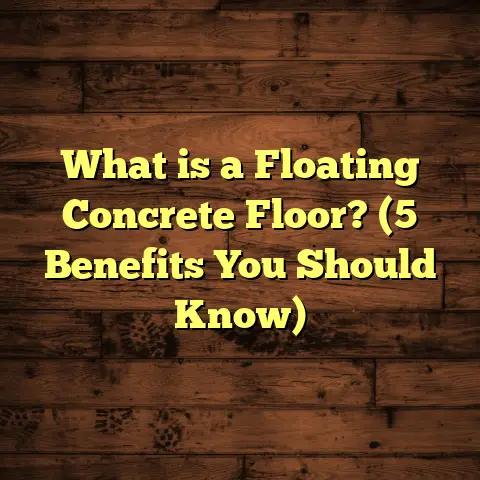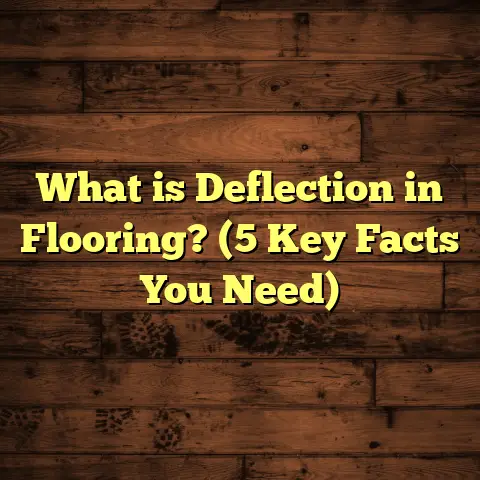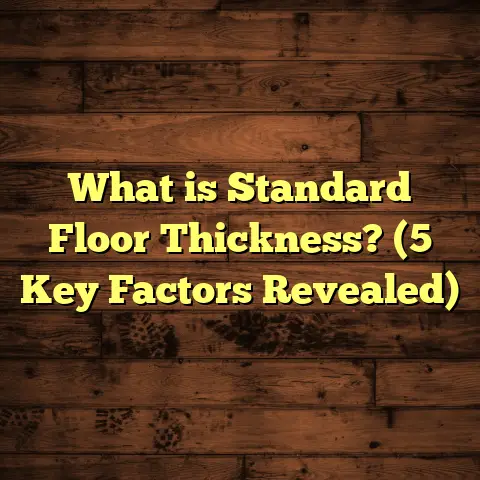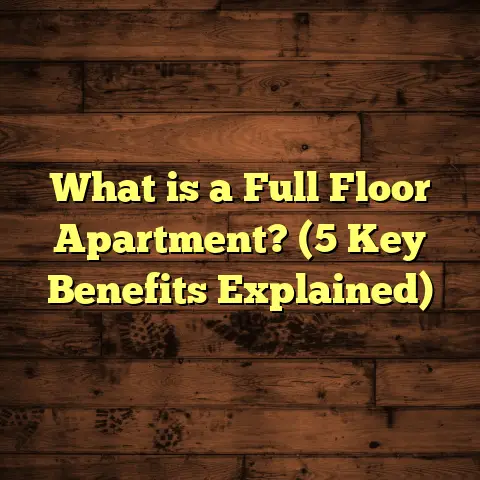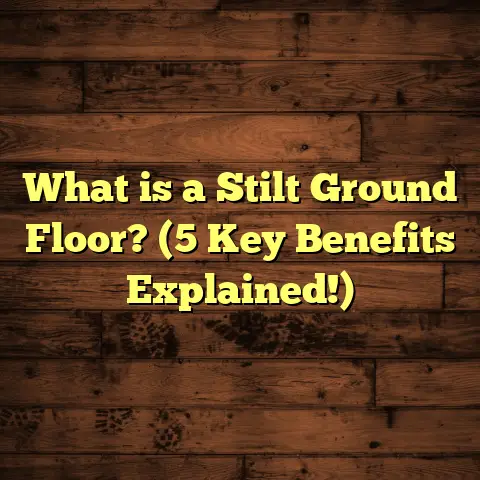What is a Polished Concrete Floor? (5 Benefits You Didn’t Know)
“Quality is never an accident; it is always the result of intelligent effort.” — John Ruskin
When I first came across polished concrete floors years ago, I didn’t realize just how much depth there was to this flooring option. It’s easy to glance at a polished concrete floor and think, “Well, it’s just shiny concrete,” but the truth is, it’s much more than that. From technical details to surprising benefits, polished concrete floors have a lot going for them—and today I want to share everything I’ve learned.
If you’ve ever asked yourself, “What exactly is a polished concrete floor?” or wondered why more people seem to be choosing it for their homes and businesses, you’re in the right place. Let’s start by breaking down what polished concrete really is.
What Is a Polished Concrete Floor?
At its core, a polished concrete floor is a concrete slab that has been mechanically ground and polished with progressively finer abrasives until it achieves a smooth, glossy finish. But don’t let that simple definition fool you—this is a meticulous process that transforms an ordinary concrete surface into something both durable and beautiful.
The Anatomy of Polishing Concrete
Concrete itself is a composite material made of cement, aggregates (like sand and gravel), and water. When poured and cured, it creates a solid floor base. Usually, concrete floors are left unfinished in many buildings—rough, matte, and porous. Polishing concrete involves grinding down the surface layer by layer using diamond-embedded pads until the aggregate underneath is exposed and the surface shines.
The process generally includes several steps:
- Grinding: This phase removes surface imperfections such as cracks, stains, or rough textures. It uses heavy-duty machines with diamond segments that slowly grind down the surface.
- Densifying: After grinding, a chemical hardener (usually sodium silicate or lithium silicate) is applied to fill microscopic pores and harden the surface.
- Polishing: The surface is polished using finer grit diamond pads in multiple passes until the desired level of shine (from matte to high gloss) is reached.
- Sealing or Staining (optional): Sometimes an additional sealer or color stain is applied for protection or aesthetic enhancement.
I remember on one project when we polished a warehouse floor, the transformation was remarkable. What once looked dull and industrial became sleek, reflecting overhead lights beautifully and giving the space an entirely new vibe.
Levels of Polish
Not all polished concrete floors look the same. The level of polish can range from a low sheen (about 300 grit) to mirror-like finishes (3000 grit or higher). Your choice depends on your aesthetic preferences and functional needs.
- Matte Finish: Minimal shine for a subtle look.
- Satin Finish: Soft sheen balancing shine and practicality.
- High-Gloss Finish: Reflects light like glass for maximum brightness.
Different levels also affect maintenance—higher gloss floors tend to show dirt and smudges more easily but offer the most dramatic appearance.
Why Choose Polished Concrete Floors? Five Benefits You Didn’t Know
Everyone knows polished concrete floors are durable and low-maintenance, but there are some lesser-known advantages I’ve discovered over the years working with these floors.
1. Energy Efficiency Through Light Reflectivity
One benefit that surprised me was how polished concrete floors can help reduce energy costs by reflecting natural and artificial light.
Concrete has a naturally reflective quality after polishing, measured by its Light Reflectance Value (LRV). The higher the LRV, the more light bounces off the floor instead of being absorbed. Polished concrete floors often have LRVs between 60% and 85%, depending on how glossy they are.
This means rooms with polished concrete floors can feel brighter without adding extra lamps or overhead lights. For commercial spaces like warehouses or offices, this adds up to real savings. In fact, I worked with a client who managed a large distribution center; after polishing their concrete floors, they reported a 25% reduction in lighting costs during daytime hours due to increased reflectivity.
Have you ever noticed how bright rooms with shiny floors feel? That’s this effect in action.
2. Allergy-Friendly Flooring Option
If you or someone in your family struggles with allergies or asthma, choosing flooring carefully can make a huge difference.
Carpet tends to trap allergens like dust mites, pollen, and pet dander deep within its fibers. Polished concrete floors don’t have those fibers to trap irritants. Dust and allergens stay on the surface where they can be easily cleaned away.
I had a client whose child was dealing with severe allergy flare-ups triggered by carpets in their previous home. After installing polished concrete floors throughout their living spaces, they noticed fewer allergy symptoms and easier cleaning routines. Just sweeping and mopping regularly kept the air fresh.
Plus, no need for expensive allergy treatments related to flooring! If improving indoor air quality matters to you, polished concrete is worth considering.
3. Longevity That Outlasts Other Flooring Types
Durability is often touted as a benefit of polished concrete floors—but understanding just how long they last can really change your perspective on value.
Concrete itself is one of the most resilient building materials around. When polished and sealed properly, these floors resist scratches, stains, and impacts better than many alternatives.
Industry data shows that polished concrete floors can last upwards of 50 years with minimal maintenance. In comparison:
- Hardwood floors typically need refinishing every 10-15 years.
- Carpet may require replacement every 7-10 years.
- Vinyl flooring can last 10-20 years depending on quality.
That means your investment goes further with polished concrete. For commercial spaces that see heavy traffic—like retail stores or manufacturing facilities—that durability translates into significant long-term savings.
In one project I worked on for a high-traffic retail store, their polished concrete floor still looked almost new after 15 years of constant foot traffic without needing refinishing or replacement.
4. Customization Beyond Just Color
People often assume polished concrete means dull gray floors—and while gray is common, there’s actually so much room for creativity here.
You can customize your floor in several ways:
- Staining: Acid-based or water-based stains add translucent color tones from subtle earth tones to rich blues or reds.
- Dyes: Offer more vivid colors with UV resistance.
- Exposed Aggregates: By grinding deeper into the slab, decorative stones like quartz or glass chips can be revealed for texture and sparkle.
- Etching & Design Patterns: Logos or intricate designs can be etched into the surface before polishing for unique branding or artistic effects.
- Integral Coloring: Pigments mixed into the concrete during pouring create consistent color throughout.
I once worked on a boutique restaurant project where we embedded recycled glass pieces into the floor before polishing. The effect was stunning—colorful specks sparkled underfoot while maintaining the durability of concrete.
If you want flooring that’s both practical and visually striking, polished concrete offers options few other materials can match.
5. Improved Indoor Air Quality (IAQ)
Indoor air quality is often overlooked when choosing flooring but it has a direct impact on health and comfort.
Polished concrete floors help improve IAQ because:
- They don’t trap moisture that leads to mold growth.
- They don’t harbor dust mites or allergens.
- They don’t off-gas volatile organic compounds (VOCs) like some synthetic flooring materials.
According to research by the U.S. Environmental Protection Agency (EPA), hard surface flooring like polished concrete generally correlates with lower levels of indoor pollutants compared to carpeted surfaces.
For families dealing with asthma or other respiratory issues, this benefit can be transformative. One homeowner told me their child’s nighttime coughing significantly decreased after switching from carpeted bedrooms to polished concrete floors with area rugs for warmth.
My Personal Journey With Polished Concrete Floors
Working as a flooring contractor for over a decade has given me insight into the real-world pros and cons of various flooring options. But polished concrete holds a special place because it blends science, art, and practicality in such an elegant way.
I recall my first polished concrete installation vividly—it was for an art gallery downtown. The owner wanted something modern yet durable enough for heavy visitor traffic. We spent days grinding and polishing that slab until it gleamed like glass. The transformation was so dramatic that visitors kept asking if it was marble or stone tile.
That project opened my eyes to how versatile polished concrete could be—not just for commercial spaces but also residential homes looking for something different from wood or tile.
Since then, I’ve installed hundreds of polished concrete floors across homes, offices, restaurants, warehouses—you name it. Each project taught me something new about techniques, materials, maintenance tricks, and customer preferences.
Breaking Down Durability: How Tough Is Polished Concrete?
Let’s talk numbers because durability isn’t just about feelings—it’s measurable.
Concrete’s hardness is measured by the Mohs scale—a scale from 1 (talc) to 10 (diamond). Polished concrete scores around 7 on this scale meaning it’s harder than steel (4-4.5) and most natural stones like marble (3-5).
Here are some relevant durability stats:
| Property | Polished Concrete | Hardwood Flooring | Ceramic Tile |
|---|---|---|---|
| Mohs Hardness | ~7 | 3-4 | 6-7 |
| Compressive Strength | 3000–5000 psi | N/A | ~15000 psi |
| Abrasion Resistance | High | Moderate | High |
| Lifespan | 30–50+ years | 10–15 years | 20–30 years |
These figures explain why polished concrete performs so well in high-traffic areas like retail stores and warehouses where forklifts or heavy equipment are common.
One client once joked that their floor “could survive an earthquake,” which isn’t far off given its toughness!
Maintenance Tips: Keeping That Shine Alive
Even though polished concrete floors are easy to maintain compared to carpet or hardwood, some care is necessary to keep them looking their best long-term.
Here are my top maintenance tips:
- Sweep or dust mop daily using microfiber tools to pick up grit that can cause micro-scratches.
- Mop with water and pH-neutral cleaners—avoid acidic or abrasive products.
- Clean spills promptly—though sealed polished concrete resists stains well.
- Use protective mats at entryways to reduce tracked-in dirt.
- Consider professional re-polishing every few years for very high traffic areas.
- Avoid dragging heavy furniture directly on the floor without protection.
A lot of clients tell me they appreciate how little time they spend cleaning these floors compared to carpeted areas which require vacuuming and deep cleaning frequently.
Cost Breakdown: What To Expect Financially
Let’s talk money because budget always plays a big role in decision-making.
The cost of installing polished concrete floors varies significantly based on factors like:
- Existing slab condition (repairs add cost)
- Level of polish desired
- Size of area
- Customization options (coloring, aggregate exposure)
- Geographic region
On average:
- Basic polishing starts around $3-$5 per square foot.
- Mid-range polish with stain or color runs $5-$8 per square foot.
- High-end customized polish including exposed aggregates or logos can reach $10-$12+ per square foot.
Compared to other durable flooring materials like hardwood ($8-$15/sq ft) or tile ($5-$15/sq ft), polished concrete is often competitive on upfront costs—especially considering its longevity reduces long-term replacement expenses.
One client calculated their total cost over 20 years factoring replacement cycles for carpet and hardwood versus one-time installation of polished concrete—and found they saved roughly 40% overall by going with polished concrete.
Is Polished Concrete Right For You?
Now that I’ve shared what polished concrete floors are and their surprising benefits, you might be wondering if they’re right for your space.
Ask yourself:
- Do I want a low-maintenance floor that lasts decades?
- Is indoor air quality important for me or my family?
- Am I looking for energy savings through improved light reflectivity?
- Do I want to customize my floor beyond standard options?
- Do I need a floor tough enough for heavy foot or equipment traffic?
If you answered yes to several of these questions, polished concrete could be an excellent fit.
Common Myths About Polished Concrete Floors
Before we wrap up, let me bust some myths I hear often:
Myth #1: Polished Concrete Floors Are Cold and Hard
Yes, they’re hard—but not uncomfortably so. And yes, they feel cool underfoot but adding area rugs or radiant heating can solve this easily.
Myth #2: Polished Concrete Is Slippery
When sealed correctly and finished at appropriate grit levels (matte or satin), slip resistance is good enough for most uses. Adding anti-slip treatments can help in wet areas if needed.
Myth #3: It’s Only for Industrial Spaces
I’ve installed polished concrete in homes, boutiques, restaurants—you name it. It’s very versatile aesthetically and functionally.
Wrapping Up My Thoughts With Some Questions for You
Have you ever walked across a polished concrete floor and wondered what goes into making it so shiny? Or maybe you’re considering flooring options for your next project?
What excites you most about polished concrete? Is it the durability? The look? The health benefits?
Feel free to reach out—I love talking about flooring choices and sharing what I’ve learned through hands-on experience plus research over the years.
